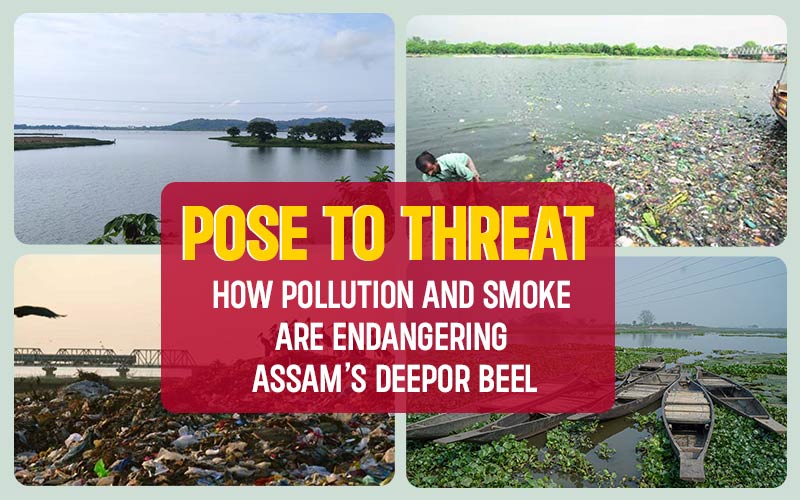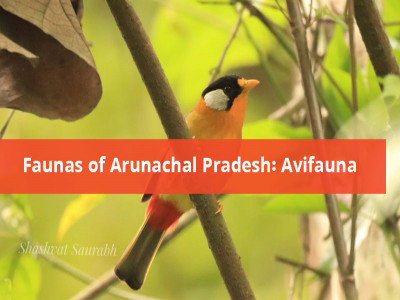
Pose to threat: How pollution and smoke are endangering Assam’s Deepor Beel
Deepor Beel, a natural wetland and the only Ramsar site in Assam, has been facing significant ecological threats due to smoke and pollutants from a nearby dumping ground. The dumping ground, located in East Boragaon’s Belortol area on NH-27 and managed by the Guwahati Municipal Corporation (GMC), has become a major source of contamination, endangering both the wetlands' biodiversity and residents' health.
If we look at the present threats, the dumping site which has been in operation since August 2021 following a National Green Tribunal (NGT) order, receives approximately 600 tonnes of waste daily from Guwahati's households and businesses. The location of this site near the Pamohi canal, which connects to Deepor Beel, has resulted in significant soil and water contamination. During the rainy season, the wetland often overflows, causing the contaminated water and garbage from the dumping site to mix with the beel’s ecosystem. This has led to severe repercussions for the aquatic life in the wetland.
Moreover, the smoke and ashes from the burning waste at the site pollute the air, further compounding the environmental damage. Residents have reported health issues due to the noxious fumes and foul stench emanating from the dump.
Deepor Beel's biodiversity is also in decline. For instance, the number of bird species has drastically reduced from around 298 in 2002 to just 155 in the latest count conducted in January 2024.
Historical and Ecological Significance of Deepor Beel
Deepor Beel, which is spread over 900 hectares, is a vital ecological zone located adjacent to the Brahmaputra River. It was declared a Ramsar site in 2002, highlighting its global importance as a wetland. The beel serves as a habitat for numerous bird species, including several migratory birds, making it a critical avian sanctuary.
The wetland's ecosystem supports a wide variety of flora, including aquatic plants such as the Giant Water Lily and water Hyacinth and various types of submerged, emergent, and floating vegetation. During the summer, the wetland teems with life, supporting both aquatic and semi-aquatic vegetation. In the winter, the dry areas around the beel transform into habitats for marshy lands, mudflats, and grasslands.
Deepor Beel is also vital to the local communities, providing a livelihood for about 1,200 families from fourteen indigenous villages. These communities rely on the wetland for freshwater fish, which is a vital source of protein and income. The health of these people is intrinsically linked to the health of the wetland ecosystem.
Coming back to the smoke pollution that has been affecting the beel, an analytical study conducted by the Pollution Control Board, Assam (PCBA) from January to December 2023 revealed alarming levels of contamination in the water of Deepor Beel. The biochemical oxygen demand (BOD) levels in the water were found to be above the prescribed standards, indicating severe pollution. Further, the pH levels occasionally recorded were higher than the acceptable range, making the water alkaline and unsuitable for aquatic life. The ideal pH for aquatic organisms is between 6.5 and 8.5; any deviation from this range can be detrimental.
The pollution has affected not only aquatic life but also the endangered greater adjutant stork, which now feeds on toxic waste at the dump site instead of its natural prey, such as fish, rats, and snakes.
Taking into account, that in 2017, the death of 26 greater adjutant storks in the garbage dump highlighted the severity of the problem, prompting the National Green Tribunal (NGT) to demand an explanation from the Assam government.
The smoke and pollution in the Deepor Beel are becoming a serious issue and this situation
requires immediate and effective intervention to preserve its ecological balance and protect the health of the local population.
The government and the civic authorities need to prioritise the establishment of proper waste management systems to prevent further contamination. This can be done by relocating the dumping site to a more suitable location away from sensitive ecological zones and implementing advanced waste treatment technologies to minimise pollution.
Moreover, a concerted effort needs to be made to restore the wetland by cleaning up the existing pollution and enforcing stricter regulations to prevent future degradation. Community awareness programs are also essential to educate the local population about the importance of preserving the Deepor Beel.
Deepor Beel is not only a crucial natural habitat but also a lifeline for many people. Protecting this Ramsar site from the adverse effects of pollution is imperative for maintaining the ecological and social health of the region. Swift and decisive actions are needed to ensure that Deepor Beel continues to thrive as a haven for wildlife and a resource for the local communities.
Disclaimer: The opinions expressed in this article are those of the author's. They do not purport to reflect the opinions or views of The Critical Script or its editor.

Newsletter!!!
Subscribe to our weekly Newsletter and stay tuned.

















Related Comments